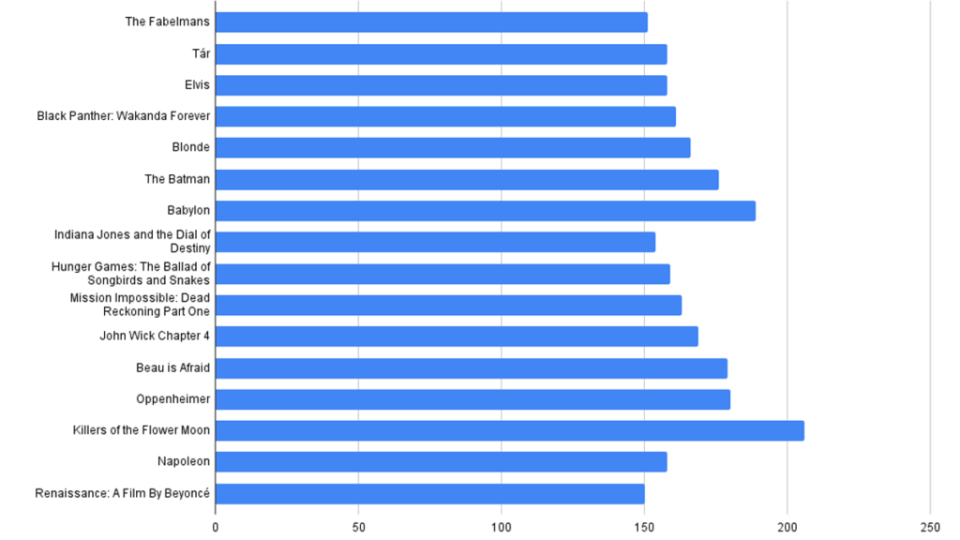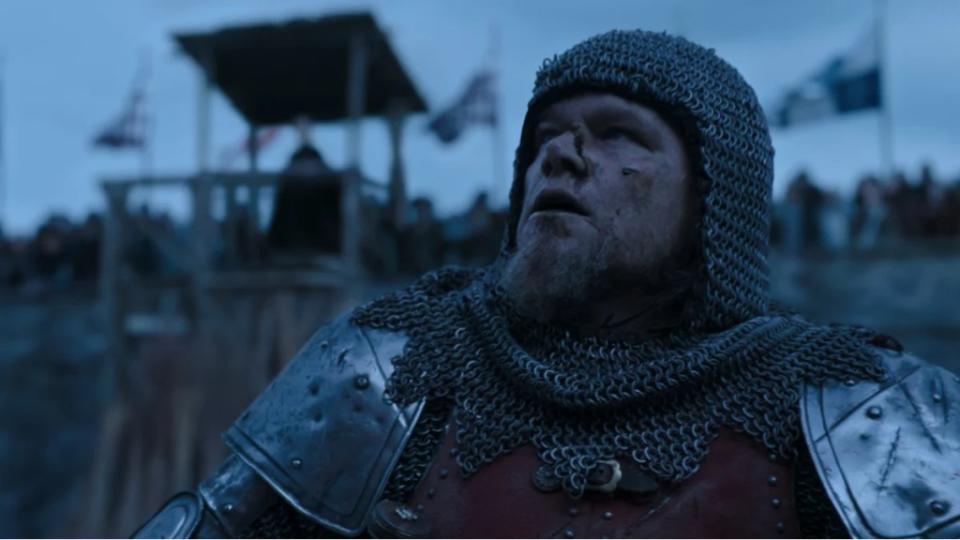No Intermission, No Problem: Why Theaters Aren’t Sweating Longer Blockbusters
It’s not just your imagination — Hollywood tentpoles are getting longer.
Whether it’s awards contenders like the three-and-a-half-hour “Killers of the Flower Moon” (206 minutes) or popcorn flicks like the upcoming nearly three-hour “The Hunger Games: The Ballad of Songbirds and Snakes” (158 minutes), movies in 2023 are testing the bladders of audiences and the patience of theater owners.
While journalists continue to debate the surge of longer-than-expected movies, Hollywood insiders and a majority of paying moviegoers see them as more of an annoyance than a problem, a recent poll shows. Theaters would generally prefer every major movie to come in at under two hours. And many audiences would appreciate an intermission. But if the movie works, the runtime is merely trivia.
Of the 10 longest movies in 2022, eight were more than two-and-a-half hours long, and two were over three hours. In 2023, seven films so far are 150 minutes or more, with two more set to debut this year — “Napoleon” and Beyoncé’s concert film “Renaissance” — for a total of nine. Of those nine, two are over three hours in length.
Long Films 2022-2023 (minutes)

But Rob Lehman, COO of Santikos Entertainment, a regional Texas theater chain, says there has been almost no pushback from customers, either in terms of long running times or the lack of intermissions for the longest of long movies. “Since the days of free refills on popcorn and 44-ounce sodas, people have been used to getting up during the movie for one reason or another,” Lehman told TheWrap.
Theaters are adjusting
Even if theaters would prefer two-hour movies — which makes it easier to program five shows per auditorium — they are pretty much stuck with what the studios offer them. And after years of comparatively paltry theatrical offerings thanks to COVID closures in 2020, COVID-caused delays in 2021 and a readjustment away from the streaming-at-all-costs strategies in 2022, beggars can’t be choosers. Theaters would rather have a new Dark Knight melodrama like “The Batman” at three hours, than not.
Nonetheless, theaters aren’t just throwing their hands up in the air. Tearlach Hutcheson, vice president of film at Studio Movie Grill, a dine-in theater chain, noted that there were some steps theaters could take to maximize the number of showtimes each day, such as programming a big movie in extra auditoriums over a low-performing holdover during peak hours.
As for the debate over intermissions, at least one high-level studio executive argued that at least some of the chatter is self-serving.
“If theaters offer intermissions, that’s another opportunity to sell more concessions,” the executive stated. He also noted that even if theaters could start implementing intermissions — currently forbidden without explicit permission from the distributor — consumers should have a choice between seeing a long movie with a break and one without.
But for now, theaters are merely accepting what they get from the studios, knowing that most uber-long movies are either year-end awards season flicks (which has been the case for decades), or otherwise preordained franchise blockbusters.
Then and now
In the days before multiplexes and digital projection, the runtime had a frankly more tangible impact on the theaters that exhibited them. First, each screen showing the film needed its own physical print, which tended to be that much heavier for the 162-minute “The Godfather Part III” compared to the 114-minute “The Silence of the Lambs.” Second, if you’re a two-screen theater and you choose to show the big new release on both of your screens, well, that blots out all other options for moviegoers.
“The more showtime choices you give a guest, the more likely the audience will choose to see a movie,” Hutcheson said. However, the new normal of digital projection and megaplexes removes that variable for most of the biggest and longest movies.
Digital projection means that multiple auditoriums can essentially share a single digital file. The 1990s-era explosion in multiplexes offering 10-20 theaters meant that the latest tentpole could be screened on multiple screens without completely shutting out the competition. That allowed audiences in major moviegoing cities to be able to see the latest blockbuster at almost any hour of the day no matter the runtime.
In a world with digital projection and megaplexes, does it still matter that “Taylor Swift: The Eras Tour” runs nearly three hours? Not so much. However, if it’s a non-tentpole film like Scorsese’s “Killers of the Flower Moon,” a Leonardo DiCaprio-starring drama that can’t get more than one or two screens in even a larger multiplex, then the runtime potentially becomes a variable.
Audiences don’t care all that much
A survey of 600 moviegoers polled by The Quorum, a film research company, found that runtime is at worst a rare deterrent. Fully half of those surveyed said they never take it into account, 35% only do so on rare occasions and 14% said it’s a frequent variable, the company told TheWrap. Of those who said it was rarely or frequently an issue, 57% would appreciate an intermission while 43% say movies should run in full without interruption.
James Cameron, while promoting the 192-minute “Avatar: The Way of Water” last year, said he had no objection if audiences picked a moment to race to the restroom amid the sweeping Pandora travelogue. “It’s OK to get up and go pee,” he told Empire Magazine. “They can see the scene they missed when they come see it again,” he told The Hollywood Reporter. The movie grossed $2.3 billion worldwide.
Sure, those who showed up on the opening weekend of Scorsese’s historical epic may have approached it like a trip to church. But most folks aren’t going to sweat it if they have to hit the restroom, grab a refill or take a phone call during the two-and-a-half-hour “Spider-Man: No Way Home.” And if they didn’t want to see longer movies like 2021’s “West Side Story” (156 minutes) or “Babylon” (189 minutes), cutting them down to 135 minutes is unlikely to change their minds. And if they want to see “Elvis,” a 159-minute runtime isn’t likely to stop them. (“Elvis” earned $288.7 million globally.)

Family night or date night?
The blow-out earnings for Peter Jackson’s Middle Earth films ($5.85 billion over six movies) and the likes of “Titanic” ($1.8 billion worldwide in 1997-1998), “Harry Potter and the Sorcerer’s Stone” ($975 million in 2001) and “Black Panther: Wakanda Forever” ($859 million in 2022), show that an unusually long movie is less of an issue if it’s a multi-quadrant tentpole that appeals to both parents and kids. Taking the kids to “Avengers: Infinity War” ($2 billion in 2018) as a family activity is a different prospect than parents leaving the kids with a babysitter for three to four hours to see the Ridley Scott-directed, R-rated, 2.5-hour “The Last Duel” ($30 million in 2021).
But even that generic simplification has its exceptions.
Audiences showed up in late 2021 to see Scott’s other R-rated, 2.5-hour adult-skewing drama “House of Gucci” to the tune of $147 million worldwide, when most studio programmers were bombing. Earlier this year, the 169-minute “John Wick: Chapter 4” ran over an hour longer than the first Keanu Reeves-led “John Wick” film and yet still earned a franchise-high $187 million domestic and $440 million global, the latter representing a 62% overseas uptick from the 131-minute “John Wick: Chapter 3.”
Still, one distribution insider speaking on background argued that plenty of moviegoers take runtimes into consideration.
“The sentiment I’ve heard,” the executive stated, “is that ‘I don’t want to be somewhere for three-and-a-half hours along with another hour’s worth of drive time.” Moreover, he stated, “A movie has to earn its runtime.”
Case in point: Christopher Nolan’s “Oppenheimer” soared to $950 million worldwide despite being an R-rated, three-hour, action-free drama. Either the COVID-era theatrical environment is even less predicated on runtime concerns or quite a few parents took their kids to the Cillian Murphy atom bomb drama and the “Wick” action sequel.
A proactive choice?
Would a shorter 155-minute version of “Killers of the Flower Moon” be more successful than the current offering, currently at $120 million in global box office? That’s no more likely than arguing that “Black Panther: Wakanda Forever” (161 minutes) would still have earned noticeably more than its $859 million global cume had it been a reel shorter. These films exist in a world where audiences claim to binge many hours of television episodes on streaming apps.
Hollywood has been here before. The film industry responded to television’s explosion in the 1950s with widescreen epics like “Ben-Hur” (212 minutes) and “Lawrence of Arabia” (227 minutes). They reacted to DVDs with mega-budget fantasy spectacles like “Spider-Man” and “Pirates of the Caribbean.” And studios countered the peril of streaming with nostalgia-targeted biggies like “Star Wars: The Force Awakens,” “It” and “Once Upon a Time in Hollywood” (161 minutes).
As Hutcheson put it: “Every time the industry needed to bring people back to theaters, the movies got longer while emphasizing spectacle.”
The post No Intermission, No Problem: Why Theaters Aren’t Sweating Longer Blockbusters appeared first on TheWrap.

